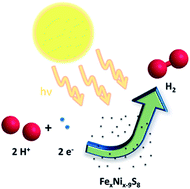FexNi9−xS8 (x = 3–6) as potential photocatalysts for solar-driven hydrogen production?†
Abstract
The efficient reduction of protons by non-noble metals under mild conditions is a challenge for our modern society. Nature utilises hydrogenases, enzymatic machineries that comprise iron- and nickel- containing active sites, to perform the conversion of protons to hydrogen. We herein report a straightforward synthetic pathway towards well-defined particles of the bio-inspired material FexNi9−xS8, a structural and functional analogue of hydrogenase metal sulfur clusters. Moreover, the potential of pentlandites to serve as photocatalysts for solar-driven H2-production is assessed for the first time. The FexNi9−xS8 materials are visible light responsive (band gaps between 2.02 and 2.49 eV, depending on the pentlandite’s Fe : Ni content) and display a conduction band energy close to the thermodynamic potential for proton reduction. Despite the limited driving force, a modest activity for photocatalytic H2 has been observed. Our observations show the potential for the future development of pentlandites as photocatalysts. This work provides a basis to explore powerful synergies between biomimetic chemistry and material design to unlock novel applications in solar energy conversion.

- This article is part of the themed collection: Artificial photosynthesis


 Please wait while we load your content...
Please wait while we load your content...